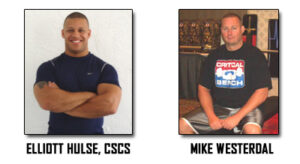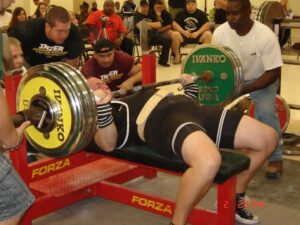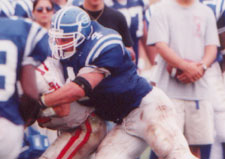Strength Training Programs: Is Cross-Training Necessary?
As I noted earlier in the week, I’m two weeks in to the new Lean Hybrid Muscle program and really enjoying it. It’s a pretty significant change of pace from what I might call my normal programming that’s geared toward predominantly increasing strength and overall athleticism – but it’s working extremely well. As the saying goes, “The best program is the one you’re not on.”
This temporary paradigm shift got me to thinking that it’d be a good idea to bring in the LHM creators, Mike Westerdal and Elliott Hulse, in for an interview to talk about whether this kind of cross-training is necessary in a strength and conditioning program. Here goes…
EC: Whenever you see people who are successful across multiple disciplines, you look for commonalities in the way that they prepare themselves. Mike, you’ve done well for yourself in powerlifting, and Elliott, you’re an accomplished strongman competitor. What do you believe to be the most important factors governing one’s success in strength sports? I figured that before we talk about what might need to be changed from time-to-time, we ought to talk about what should always stay the same.
EH: In my experience there are only a handful of tired and true principles that govern success and achievement in all areas of life. Whether you are a strength athlete or a stay-at-home-mom, the same principles apply. Like Ralph Waldo Emerson once said, “methods are many, but principles are few.” So, instead of spouting off some of my training methods here, I will share three foundation principles that I tend to value and refer to most when taking aim towards any particular goal – strength or otherwise.
The first is CLARITY. It is paramount that we know exactly what effect we would like our actions to produce. You cannot hit a target that you can’t see.
The next is COMMITMENT. Most people have a vague and fuzzy idea of what they want, but even worse is that most think of these things as “nice-to-haves,” as opposed to “I-WILL-haves.” The difference between someone who is “trying” to win because it would be nice and the person who DOES win is commitment. Winners commit 100% to reaching their goal. They never have a backdoor to escape and never take “no” for an answer.
The third principle governing one’s success is DISCIPLINE! I once heard that discipline is, “doing what you have to do, whether you feel like it or not.” I like to think of myself as a robot. Once I set my mind on a particular target, I must then put fickle emotion aside and continue to do everyday what I set out to do from the get-go…whether I “feel like it or not.”
MW: Elliott is a tough act to follow when it comes to success. A lot of people – myself included – like listening to him not only because of his strength and conditioning knowledge but also because of his general leadership when it comes to personal development in other areas of life as well.
Eric, this a great question. I’ve actually had the privilege of interviewing hundreds of different athletes for a book I published at Critical Bench. It included in MMA fighter, powerliftes, strongman competitors, bodybuilders, pro athletes and industry experts. I’ve thought a lot about this and really tried to figure out the common denominators when it comes to excelling in sports.
It almost never has to do with an exact training method or style. Guys get huge with heavy lifting and guys get huge with volume training. Powerlifters have attained world class status having trained with Westside as with Sheiko training. What it really comes down to is a few other factors that I’ll list below:
-You have to surround yourself with other successful people: people that are already in a place where you want to go. If you hang around with a bunch of lazy deadbeats you’re going to get dragged down with them. Instead, find people that are the best at what they do and try to make them a part of your life.
-To take this a step further you have to visualize yourself or imagine yourself becoming what you want before it’s ever happened. If you don’t already think you can bench press 600 pounds there’s no way that will ever manifest itself in real life until you brain can accept it as reality.
Now you may think this is hocus pocus talk, but when they asked Joe Montana what it felt like to win the Super Bowl. He said it felt like the other 300 times I won it. The reporter said, “300 times?” “That’s right” Montana replied, “I’ve been winning the Super Bowl in my backyard since I was 12-years old.”
-The next thing I see from a lot of successful strength athletes is sacrifice. Many things in life are possible, but you have to decide if what it takes to reach that goal is worth the sacrifice. The energy you exert on a certain sport may affect your energy levels for other areas of your life. During a heavy powerlifting cycle, I’m toast even when I’m not training. I find myself resting a lot more. So you have to ask yourself. What exactly do you want and are you willing to do what it takes to achieve the goal? So guys who get to the very top level often sacrifice things like certain social events, for example.
-My cousin is a successful business owner and recently gave me a valuable lesson that I believe can be applied not only to business, but also to strength sports. He told me to just keep showing up. It sounds pretty simple but most people don’t have the consistency to just keep showing up and stick with something until the end. Lots of small steps over a long period of time add up. Unfortunately, it’s very rare that you’ll find a secret shortcut or magic bullet. Just keep showing up and over time you’ll get better.
-My last point is similar to my first point. I mentioned surrounding yourself with successful people. You also need to eliminate negativity from your life and your training. If people are complaining about bad luck, aches, pains, circumstances and a host of other problems, you can’t let that stuff get into your head. I swear these things happen to these people because that’s what they think about and talk about all the time. Why not spend your time with people who are focused on where they are going and what they want?
EC: Great points – and definitely a lot of stuff that I’ve seen in my successful clients and training partners, too. Back to the subject at-hand, though: “cross-training” within a strength training program. How often do you guys intentionally deviate from your “normal” programming – whether it’s to shake things up for specific physiological reasons or just to get a little mental break?
MW: As a competitive powerlifter I trained the same way for several years straight. This is not the fault of the sport, but I was doing the same kind of training for too long. I believe that the lack of conditioning and doing the same strength exercises for too long eventually led to me gaining some unnecessary weight and even contributed to a lower back and shoulder injury.
Now, I love powerlifting and if your only goal is one-rep max strength, it’s the way to go. I wanted to drop a weight class, heal up some injuries, and get some of my athleticism back, though, so it felt good to try a more hybrid program. If you compete in any specific sport you need to train for that sport. However, at this stage of my life I have multiple goals and feel that training for them at the same time is working since I’m not trying to be the absolute best at any skill set. I do want to compete again and when I do I’ll have to cut back on the conditioning and hypertrophy work and focus more on nervous system training again. For now, though, I’m really enjoying the feeling of being more well rounded and athletic.
EH: As a professional strongman I had followed a pretty similar program of power-building mixed with strongman implements for about 3 years straight, never “mixing it up.” This not only led to weaknesses in some areas of overall health and performance, but also created the muscular imbalances that caused me to tear my biceps tendon last spring.
Now, I am committed to working towards multiple performance goals within 12-24 month periods so as to avoid the lopsidedness that caused my injury. For example, I have gone from competing as a pro strongman to running a 10 mile “psycho race” called the Tough Mudder this spring. Next, I am going to qualify for the Crossfit games before building my lifts back up to compete in a raw power lifting meet in the winter.
This may sound crazy to most people, but I’m going to give it a try. It doesn’t mean that my new approach is the right one for everyone, but I’d like to see if it is possible to excel in multiple fitness qualities at once. And I do recognize balance as a foundational principle as well.
EC: How long do these “cross-training” periods typically last?
EH: If you mean “periods” as in using hybrid training for only a portion of time during the year, then I would say “forever” – unless you are a professional athlete or bodybuilder who needs to excel in one fitness quality over another in order to compete in your sport.
If building a leaner, more functional and athletic physique is your goal, then I invite you to use this type of training all the time. The beauty of hybrid training is that you can adjust your parameters in order to emphasize one quality over another. For example, if building muscle mass is your goal, then you would continue to use more strength and hypertrophy work over conditioning – but without totally ignoring the latter.
MW: That would depend on who you’re asking. If you compete in a sport with a specific skill set like powerlifting this would be more an off-season conditioning program to do for a couple months. I see a lot of powerlifters train 12 weeks for a meet followed by two weeks completely off. Of course, there are deload weeks in the meet cycle as well. I’ve seen guys throw together three of these 12-week cycles back-to-back. After that, they usually know they need a break or their body forces them to slow down. Adding in some cross training workouts or hybrid training could be beneficial at this time for a couple months.
Now if you don’t compete in a specialized sport I truly believe you can train “Hybrid Style” all year long. You’ll feel good, look good and have great conditioning. If you decide to compete in any one area of fitness you’ll need to focus more on that area, though, to be competitive.
EC: How about when you return to your “conventional” programming? What kind of favorable adaptations (or unfavorable de-adaptations) have you seen?
MW: The biggest advantage I can see when returning to powerlifting would be injury prevention. With the different programming, I get a chance to work on any imbalances and heal up any nagging injuries. The health benefits are there too. The reduction in body fat and the cardiovascular conditioning helps me perform better on dynamic training days.
The down side is that my one-rep max strength takes a bit of a hit and I have to get the nervous system re-adjusted to doing really heavy weights. I am really glad that Lean Hybrid Muscle has powerbuilding days so that I can maintain some strength.
In my case, coming from a powerlifting style of training, strength was down a bit. However, for someone that has never trained with triples, doubles. or singles they could absolutely increase strength while following this program.
EH: The fact is that if you are working toward excellence in one particular fitness quality and you incorporate too much training from a contradictory quality, your performance will suffer. I make no claims otherwise and my experience tells me it’s true.
So, the leaner more conditioned Elliott Hulse no longer has the strength to log press 365 lbs over head, I can no longer front squat 455 lbs. So, strength has been lost.
However, things are far more balanced, where now I can only front squat about 365, I can also run a mile under seven minutes and I don’t bend over panting for air after climbing a flight of stairs, like the bigger, stronger version of me did. Ha!
EC: Not a bad tradeoff at all! Thanks so much for your time, fellas.
For more information on Mike and Elliott’s strength and conditioning programs, check out Lean Hybrid Muscle.
Sign-up Today for our FREE Newsletter and receive a detailed deadlift technique tutorial!










